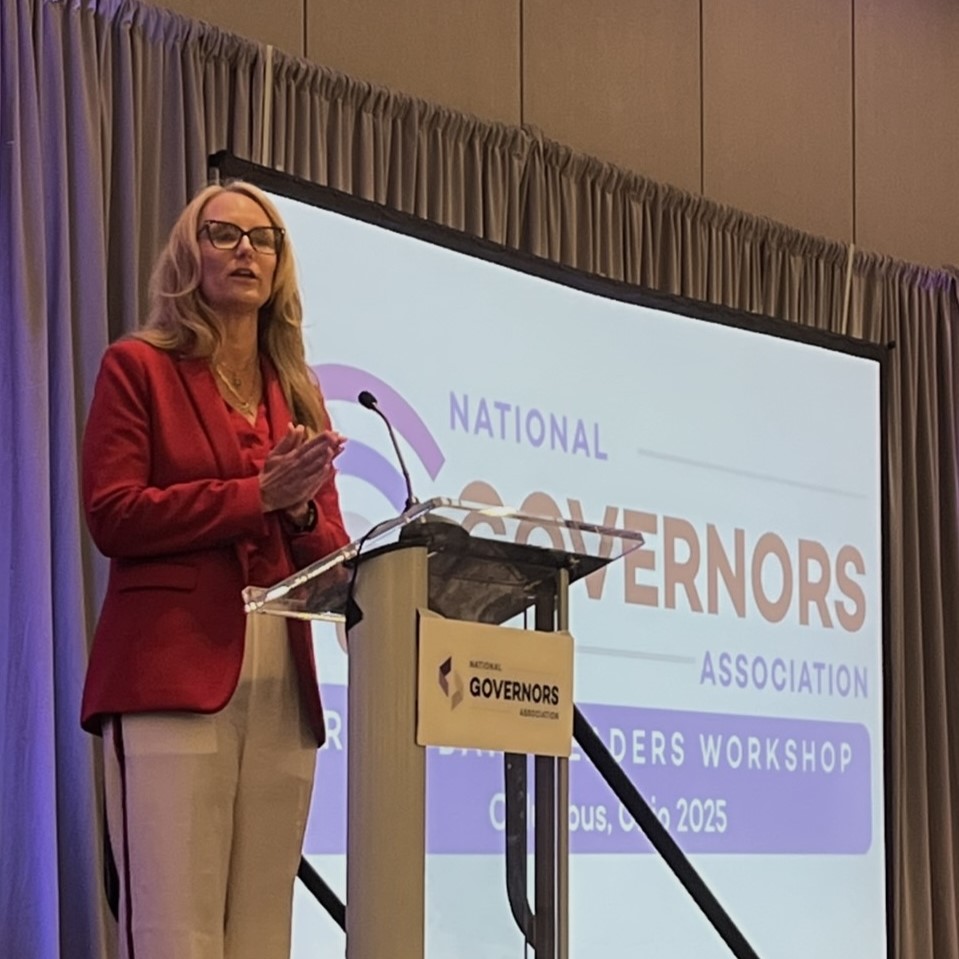STATEMENT FOR THE RECORD
Captain Chris A. Kelenske
Deputy State Director/Commander
Emergency Management and Homeland Security Division
Michigan State Police
On behalf of
The National Governors Association and the
Governors Homeland Security Advisors Council
Submitted to the House Committee on Homeland Security
Subcommittee on Emergency Preparedness, Response and Communications
United States House of Representatives
The Future of FEMA: Stakeholder Recommendations for the Next Administrator
Thank you, Chairman Donovan, Ranking Member Payne, and distinguished members of the subcommittee for allowing me to appear in front of you today to discuss the future of the Federal Emergency Management Agency (FEMA). My name is Captain Chris Kelenske and I serve as the Deputy State Director of Emergency Management and Homeland Security and Deputy Homeland Security Advisor for Michigan Governor Rick Snyder. I am here today on behalf of the National Governors Association (NGA) and the Governors Homeland Security Advisors Council (GHSAC).
The NGA is the bipartisan organization of the nation’s governors. Through the NGA, governors share best practices, speak with a collective voice on national policy, and develop innovative solutions that improve state government and support the principles of federalism.1 The GHSAC serves as a forum for governors’ principal homeland security advisors from each state, commonwealth, and territory. The GHSAC’s mission is to provide a unified voice on national homeland security policy, keep governors abreast of the current threat environment and federal homeland security legislation, and share best practices. My testimony today will focus on three goals the next Administrator of FEMA should strive to achieve. These goals are maintaining strong state-federal partnerships, supporting state and local grant programs fully, and embracing innovative solutions to both emerging and chronic emergency management challenges.
Emergency management has made significant improvements in the last decade. Since Hurricane Katrina, the all-hazards, whole community approach to disasters resolved many of the devastating consequences realized during the Hurricane Katrina response effort. Both states and the federal government have committed vast resources to institute sound preparedness, response, and recovery activities to minimize the impact of disasters. Governors are committed to seeing these efforts continue for years to come and believe the next FEMA Administrator is instrumental in achieving that goal.
Governors have a vested interest in having a strong FEMA Administrator who respects the role and authority of states in disasters and recognizes past achievements. Equally important, governors want a FEMA Administrator who encourages a collaborative approach to emergency management and not one that imposes strict, burdensome mandates on states.
The next Administrator will set the direction of emergency management for the next decade. Whomever inherits the role must sustain momentum built to improve emergency management activities across all levels of government. For the next Administrator to be successful, he/she should:
- Embrace states as key partners in emergency management;
- Align investments to better match current threats, hazards, and capability gaps; and
- Recognize past progress, but embrace innovative approaches for future policy development.
Embrace States as Key Partners
States are the linchpin for emergency management activities. The Robert T. Stafford Disaster Relief and Emergency Assistance Act places the responsibility of requesting federal assistance on the governor, a responsibility that underscores the essential role of the state. Governors and their key advisors also serve as a connective node to local government, federal government, nongovernmental, and private sector officials. FEMA can use this knowledge base and rely on the state as a resource when working with communities.
Yet, FEMA has not reached out to states consistently in the past. Instead FEMA has reached out to specific communities without consulting the governor or state emergency manager. Direct outreach to local officials with limited or no state involvement can cause FEMA to miss larger contextual issues. Local governments have the specific and nuanced context for their individual communities, but governors have an enterprise-wide, holistic view of the state emergency management operation. FEMA should consult with governors to understand the broader impact of federal investments and the investments smaller communities make on the overall state preparedness picture. Not engaging state officials alongside local representatives can undermine emergency response efforts and shift resources away from where they are needed most. The next Administrator needs to recognize that the state plays a critically important intermediary role between the federal and local governments. FEMA must ensure that state officials are present in disaster response and recovery activities so that they have maximum affect for the state. Similarly, the next Administrator should understand the consequence of not working through the state is less effective emergency management.
The partnership between FEMA and the states has improved dramatically in the last decade. Not only with leadership at FEMA headquarters but also with the regional offices. Governors want to see this partnership continue to thrive under the new Administrator. The next FEMA Administrator can accomplish this goal by continuing to engage with governors often and early. State stakeholder groups such as the NGA and the GHSAC provide a platform for the Administrator to use. These forums allow the Administrator to learn about state concerns and provide consistent and timely responses. Additionally, this engagement enables states to provide direct feedback on FEMA policy and planning documents early in the process.
In the past, FEMA has not meaningfully engaged with states in policymaking and any engagement has occurred late in the process. Recently, FEMA has actively solicited state feedback. Governors want to see this outreach continue as it offers them the ability to provide detailed and thoughtful analysis that FEMA may incorporate into their policies. Ensuring that governors’ voices are reflected in FEMA’s policymaking process will demonstrate that the new Administrator values the state-federal partnership and will actively work to support it.
Align investments better to current threats, hazards, and capability gaps
States, locals, and the federal government have spent billions of dollars through the FEMA grant programs to ensure all levels of government are prepared for any event. Those grants have helped states and localities build capabilities such as emergency communication networks and information-sharing networks like the national network of fusion centers. State and local capabilities have a nationwide benefit. They help build capacity and resources that the federal government does not have to build itself but can rely on in the event of a crisis. Because state and local capabilities are in place the federal government may focus efforts on more critical gaps and vulnerabilities.
Over the past several years, cuts to federal grant programs for states have made it difficult to sustain progress and build new capabilities. Moreover, these cuts have come at a time of new, emerging threats, such as homegrown violent extremism and cyber network breaches. While federal expectations of states have increased to accommodate these new threats, there has been no increase in federal financial support, reflecting a lack of meaningful federal assistance. This dichotomy highlights foundational issues and inefficiencies within the current grant structure. The homeland security grant program (HSGP) is a prime example of this issue.
Created in the wake of the September 11th attacks to prevent a similar attack from occurring, the HSGP has remained unchanged since its inception. At its peak, the program consisted of almost 20 different grant programs intended to address a very narrow, specific threat. While some consolidation of programs has occurred over time, the HSGP remains an amalgamation of many different priorities. That structure along with decreased funds and increased responsibilities have stressed the programs limits and highlighted inefficiencies that include burdensome administrative requirements and redundancies. In its current form, states struggle to utilize the HSGP to sustain existing capabilities and build new ones simultaneously. More importantly, the funding restrictions on how and what grant recipients may use the funds towards creates significant difficulty for states to adjust activities to match the current threat environment.
Reform is necessary to ensure the long-term viability of the HSGP and maintain the nation’s homeland security. The HSGP requires a more flexible framework that is adaptable to a dynamic threat environment. This will allow states to act more nimbly and focus on capabilities that match current threats. The next Administrator should work with states and Congress to identify ways to reform the HSGP. Governors support comprehensive grant reform and have developed principles to help guide those efforts. As outlined in NGA’s recommendations for the new administration, any “reform should focus on creating a sustainable funding program that eliminates inefficiencies, provides greater flexibility, streamlines administrative requirements and prioritizes outcomes that reduce risk and improve overall preparedness, response and recovery.”
Federal grants for homeland security and emergency management activities are an efficient way to build capabilities nationwide and reduce overall expenditures, which provides a return on investment to the federal government. States and locals respond to numerous disasters without federal support. In 2016, states responded to more than 30,000 disasters without requesting a Stafford Act declaration. These capabilities are possible because the federal grant programs help states establish core functions to handle the less extreme events so the federal government can focus on responding to the catastrophic events.
Reductions in federal grant funding will further erode state and local capabilities. Moreover, reductions in federal funding jeopardize state investments in emergency management activities. For example, the Emergency Management Preparedness Grant Program requires states to match federal investments dollar for dollar. Similarly, the Emergency Management Assistance Compact (EMAC)—the interstate agreement for mutual aid—allows states to share resources among each other. EMAC supports the notion of regional assets and capabilities, which allows states to lean on each other rather than on the federal government. Both these examples demonstrate state-owned resources such as personnel, funding, and equipment to support emergency management functions. Although FEMA supports these programs through yearly appropriations, states bear the brunt of the responsibility for implementation.
Ongoing, dedicated federal support is crucial to ensure states and localities have sufficient capacity to handle more routine disasters. Governors and the federal government share the responsibility of ensuring the safety and security of the citizens of the country. States have continued to respond efficiently to disasters even with decreased federal support. However, states cannot maintain the status quo indefinitely. The next FEMA Administrator must ensure that states and localities receive dedicated, ongoing funding commensurate with the level of federal expectations and requirements. Without it, the nation’s overall preparedness will suffer and progress made squandered.
Recognize past progress, but embrace innovative approaches for future policy development
FEMA’s recent history serves as an important guide for the next Administrator. Following Hurricane Katrina, states, localities, and the federal government implemented reforms to emergency management activities to emphasize all-hazards planning among all levels of government, nongovernmental organizations, and the private sector. FEMA spent time, effort, and manpower to develop a new, comprehensive emergency management foundation. These reforms have led to the creation of standards for incident response that previously did not exist or were executed inconsistently. For example, the National Incident Management System (NIMS) provides the whole community with an approach to manage the after-effects of disasters in a collaborative and consistent way. Previously, no true standard existed. NIMS provides that standard and helps identify what progress has been made and what challenges remain.
The development of the National Preparedness Goal and the National Preparedness System (NPS) has helped to deepen those efforts. Having a vision for preparedness and defined nationwide capabilities necessary to meet that goal helps to establish expectations. Improvements to the NPS may be necessary, however states have spent considerable time and effort to contribute and align policies to the NPS. States want to continue those efforts, improve upon them, and ensure the NPS thrives in the long-term. The next Administrator should view items like the NIMS and the NPS as foundational to FEMA and ensure the Secretary of Homeland Security fully understands FEMA’s capabilities and position within the U.S. Department of Homeland Security. A federal commitment to honor these programs will demonstrate to governors that the Administrator recognizes past progress and wants to make further advancements.
The existing emergency management system has made impressive progress. However, more opportunities for improvement exist. For example, the Threat Hazard Identification Risk Assessment (THIRA) and State Preparedness Report (SPR) created under the NPS are still evolving and require additional fine tuning. States need further clarity on how THIRA and SPR inform FEMA’s threat picture and what effect, if any, that has on the allocation of financial resources and other types of support to states.
Previous gains are at risk of regression or neglect. The next Administrator will have a profound role in steering the future course of emergency management, which will require innovative approaches. However, that must be balanced with the need for change to improve outcomes versus the desire for change solely for the sake of change. Several areas that will require innovative solutions from FEMA include:
- Public Assistance Changes. Proposed changes to the public assistance program, specifically, the disaster deductible, represent a cultural shift in emergency management. Governors appreciate the goal of trying to reduce risk and overall costs. Governors, like the federal government, want to be good stewards of federal investments. However, this concept will require time for states to fully understand the intended and potentially unintended adverse consequences. In the initial rollout, governors appreciated FEMA’s outreach for feedback. Governors also encouraged FEMA “to maintain the current threshold requirements without imposing additional financial burdens on state and local governments through a deductible.” Many questions remain about the proposal and it is unclear whether the deductible can achieve its primary goal to improve disaster outcomes. Therefore, the next Administrator should take careful consideration in moving forward and consider how the concept will affect states in the short and long term. NGA will review the revised notice and provide additional feedback on behalf of the nation’s governors.
- Cybersecurity. The nation’s cyber networks are vulnerable to attack from both state and non-state actors. States own a great deal of personal identifiable information and have witnessed the theft of those records in Utah and South Carolina. Additionally, the increasing reliance on the Internet for everyday functions has created additional vulnerabilities to essential industries, such as finance, healthcare, and energy. Under the leadership of Michigan Governor Rick Snyder and former Maryland Governor Martin O’Malley, NGA created the Resource Center for State Cybersecurity, which has helped bring this issue to the forefront across the nation. Governor Snyder’s continued focus on cybersecurity from a state, national and international perspective, along with NGA Chair and Resource Center co-chair Virginia Governor Terry McAuliffe’s initiative Meet the Threat: States Confront the Cybersecurity Challenge,states have received increased guidance on how to tackle cybersecurity challenges in numerous areas to include emergency management. The possibility of a cyber breach with significant physical and non-physical consequences to states is real. What remains unclear is what federal support, if any, states would receive from FEMA if the damage exceeds state capabilities. In addition to reforming the HSGP to help states build the necessary capabilities to prepare for cyber incidents, FEMA should clarify the use and application of the Stafford Act for both disasters with physical consequences and those without.
- Disaster Relief Fund. The disaster relief fund (DRF) allows FEMA to “direct, coordinate, manage and fund eligible response and recovery efforts associated with domestic major disasters and emergencies that overwhelm state resources” as allowed under the Stafford Act. This fund ensures FEMA can provide adequate relief to states and localities affected by disasters. However, recent attempts to make the fund available for other purposes outside of its original scope, such as wildfire suppression activities on federal lands, threaten its core mission and availability for emergencies. Any expansive use of the DRF outside the scope of the Stafford Act may have an adverse impact on disaster response by slowing down activities and preventing states from accessing critical resources. Governors believe in the importance of the DRF and want to ensure it serves its intended purpose. The FEMA Administrator should work to preserve the fund for state and local emergency management response and recovery as well as encourage other agencies to work with Congress to identify alternative resources to meet their needs to the fullest extent possible.
- Disaster Resiliency. Disasters have increased in severity and frequency in recent years, resulting in an increase in disaster costs. Congress has charged FEMA with identifying ways to reduce those costs. Simultaneously, states—who share in disaster expenditures—are working to bolster resiliency, a mission made more challenging because of the nation’s aging infrastructure. Congress should include resiliency as a factor in any proposals to improve the nation’s infrastructure to ensure our vital structures can withstand future disasters.
FEMA should look to the states for innovative resiliency solutions. For example, the Colorado Governor’s Office of Recovery and Resiliency has developed a resiliency framework that analyzes changing risks and vulnerabilities and guides long-term resiliency investments. New Jersey established an energy resilience bank (ERB) that supports the development of distributed energy resources at critical facilities so that they remain operational in future outages. The financing provided in the ERB will help to incentivize the implementation of resiliency solutions and minimize the impact of future major power outages caused by severe weather or man-made events.
Emergency management is constantly evolving and must quickly adapt to new threats and hazards. The next Administrator will be responsible for shaping our nation’s emergency management priorities. The nation’s governors are committed supporting that effort and stand ready to assist.
I look forward to working with the next Administrator and welcome additional dialogue with subcommittee members concerning the importance of maintaining a robust national emergency management system. Thank you again for the opportunity to appear in front of you today. I welcome any questions you may have.
2. “We the States: Governors’ Recommendations for President Trump,” National Governors Association, accessed February 7, 2017, https://resources.nga.org/cms/wethestates/hsps.html.
3. “Recommendations for Strengthening National Emergency Management Programs,” National Emergency Management Association, accessed February 7, 2017, https://www.nasemso.org/Projects/DomesticPreparedness/documents/NEMA-Recommendations-for-Strengthening-National-EM-Programs.pdf.
4. Nixon, Jay and Hutchinson, Asa, FEMA Disaster Deductible Concept, National Governors Association, https://classic.nga.org/cms/home/federal-relations/nga-letters/homeland-security–public-safety/col2-content/main-content-list/fema-disaster-deductible-concept.html (March 21, 2016).












